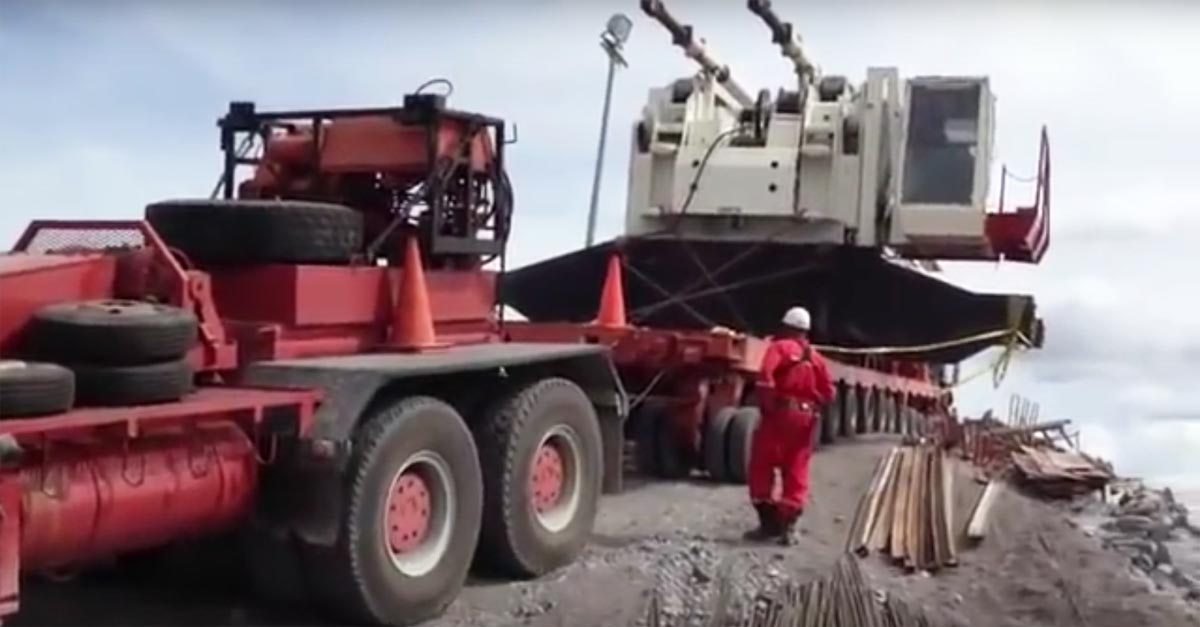This incident is hard to take in, especially if you work in construction. There are always big machines present, work hazards, and every now and then the need to move one massive piece of machinery from point A to point B. When those times are necessary, you do like these fellows here… take all necessary precautions, and move real slow. That sounds like such an easy plan, doesn’t it?
Two simple points to follow. Well, if not for the downhill grade, it would be quite simple indeed my friend. However, as with most things involving massive amounts of weight and gravity, gravity usually wins. No matter what this guy in the lead truck does, he is not going to stop the inertia of something weighing several tons more on a downhill slope.
But it is the ending that gets you, am I right?
There’s something about seeing that massive machine slide off of that flatbed that just knots up your gut. This is the type of thing that OSHA compliance regulators dream of. It’s the stuff of construction foreman nightmares. Because sometimes the truth of the matter is this, no matter how careful and slow you go, bad things are bound to happen.
(more…)
Read More
Yet, all is not lost. In fact, this mishap really isn’t as bad as it seems. Sure, a massive piece of machinery, which looks to be something like the base piece of a crane, has i
Exactly How Bad Is It?
Yet, all is not lost. In fact, this mishap really isn’t as bad as it seems. Sure, a massive piece of machinery, which looks to be something like the base piece of a crane, has indeed taken a slip and slide trip right off the edge of a long, expensive flatbed. Yet, for those who work in the industry, you know exactly what will happen next. For those who do not, let me explain. When you are on a big construction site like this, thinking on your feet is a handy skill to have. It should be a requirement, because things like this will happen. Murphy always comes to visit the job site when things are going well. Most likely what will happen from this point involves an excavator, and as many 50 to 100 ton jacks as are necessary. The excavator will come in from the side and cut in a new road. The jacks will be used to lift the massive piece of machinery up so the flatbed can be positioned underneath. These jacks are often used for military machines. Once the machine is checked for damage and loaded, it can be well on its way to the bottom of the hill. This could literally take as little as one day. Not much time lost when working against a deadline.
How to Stop a Multi-Ton Disaster
I know what you are really thinking, though. Could this mess have been prevented in the first place? Well, maybe so. From a safety standpoint, it would be nice if every axle had locking brakes on it. That would be ideal. It does not appear to be the case here. It looks as if the sole responsibility for stopping that massive load lay squarely on the shoulders of the lead and rear big rig drivers. It appears that the driver tried to lock the brakes on the lead semi truck. This is evidenced by the nice jackknife slide he gives us on the way down. The proper thing to do in a situation like this is avoid breaking as much as possible. You want to maintain a minimal speed on the downhill slope to allow the tires and tread to do what they do best, provide traction. Then, as you attempt to decelerate the massive piece of machinery, the rear driver should apply his brake, along with the lead driver. This would provide enough deceleration to accomplish a full stop as the vehicle reaches the bottom of the hill, provided there is 50 to 60 yards of space to give ample distance.
Maybe if they had tried that, the machine would have reached its destination unscathed. It doesn’t matter either way now, though. I guarantee you they will not put those two behind the wheel of a truck again. In fact, they probably won’t put them behind the wheel of a pallet jack. Besides, they are probably still changing there pants anyway. Take a look one more time and riddle me this… was one load lost, or three?
Read Less
